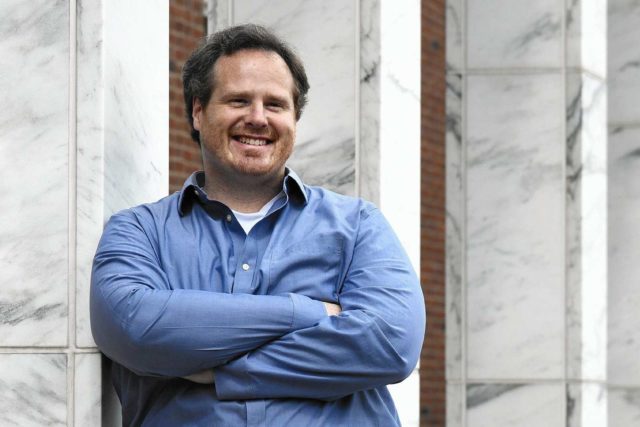
Johns Hopkins scientists join others to complete the human genome, expanding potential for better health care Michael Schatz, a Johns Hopkins professor of computer science and biology, is part of the team that it has completed the human genome map. (Amy Davis/Baltimore Sun/TNS)
Two decades after the scientific world released a first draft of the human genome, a research consortium said Thursday that it has completed the genetic map, opening vast new opportunities to understand the makeup of the human body and improve people’s health.
About 100 government and academic scientists, including some at Johns Hopkins University in Baltimore, worked on this last part of the Human Genome Project, adding the last and most confounding 8% of genes missing from the blueprint for the human species. They called it a massive undertaking that deployed far more advanced technology than was available 20 years ago.
“Eight percent feels at first glance like a small number,” said Michael Schatz, a consortium member and Johns Hopkins professor of computer science and biology. “But that’s the size of Africa; a whole continent was missing.
“We found more than a million additional genetic variants,” he said, “and each variant is associated with a specific disease.”
Gene sequencing has been used in the lab for years to understand broadly how traits and diseases develop — think about how the BRCA gene mutations make a woman more likely to have breast and ovarian cancer. In some cases the information has allowed scientists to develop new therapies and led doctors to tailor treatments to individuals.
That can now expand exponentially, and with all the information available, provided all the world’s labs switch to the new map, Schatz said.
About 30 institutions added or corrected more than 200 million DNA base pairs, increasing the number in the human genome to 3.05 billion. Those base pairs, made of chemical copies of genetic material bound together, form about 25,000 distinct genes.
Scientists including Schatz discussed the finding in a news conference Thursday with those from the National Institutes of Health’s National Human Genome Research Institute, the University of Washington and the University of California, Santa Cruz.
After pushing their research through the coronavirus pandemic, sharing information on the Slack messaging and Zoom meeting apps, the group published six main papers Thursday in the journal Science. The group is formally called the Telomere to Telomere (T2T) consortium. A telomere is the end of a chromosome, made up of sequences of DNA.
The cost to do this work was in the millions, but a far cry from the billions used to create the draft, said Adam Phillippy, consortium co-chair and head of the National Human Genome Research Institute’s Genome Informatics Section.
The cost and complexity means it’s not yet common for a person to have their genes mapped out, but the new findings and advancements in technology could make it far cheaper and more common for doctors to go looking for genetic defects in their patients that have immediate implications or effects down the line, he said.
Patients can now have their personal genome mapped and analyzed for several thousand dollars, depending on the specific needs, and it’s not typically covered by insurance.
“In 10 years for less than $1,000 you may be able to go into a physician’s office and map your genome,” he said.
The new map was not based on one particular person but an amalgamation of people, and better reflects variations among different populations, the scientists said.
They also said fixes in the new genomic map will help researchers trying to understand the basics of disease development and progression, the aging process and other human traits because they will have more and better information.
Schatz, for example, said his lab already has begun investigating the genes associated with some cancers and it plans to begin a project looking into pediatric cancers based on the new information.
“We’re looking at the high rates of cancer in some families and this will shed light on the genetic contributions,” he said. “In the pediatric cancer work starting tomorrow, in the same spirit, we’re sequencing data collected from about 1,000 individuals across a few hundred families, and in some cases we’ll be able to identify major genetic changes.”
Other scientists are looking into genes associated with autism spectrum disorders and other diseases and conditions. There already are a lot of genes linked to specific diseases, but now researchers may find new, and possibly more meaningful combinations that mean a small or large jump in a person’s risk of getting sick.
Schatz said some of the most common genetic testing already available to consumers is through genealogy websites that trace a person’s roots. They look at common variants to get a good idea where people’s forebears came from, sometimes just the continent, but sometimes more specifically the country or even the village.
He said the companies also are able to tell people about their risk for different diseases, with BRCA being the “most famous example but a there are a few thousands variants for different diseases.” He said sometimes there is an intervention such as changing your diet or more extreme measures such as mastectomies.
Specific genetically linked treatments are beginning to trickle out, he said, but developing more is the goal.
The new map is particularly gratifying to Schatz, who was inspired by the original Human Genome Project to switch careers from cybersecurity to genomics in the early 2000s.
“I always believed this could be done,” he said. “But I don’t think anyone really knew when it could be done and what it would really take. I thought it was going to take many more years. It really was a surprise to me how quickly we could get through it.
“This is something that’s been a pursuit of mine for 20 years. So, it is incredibly satisfying to see it come together.”
___
© 2022 Baltimore Sun Distributed by Tribune Content Agency, LLC




